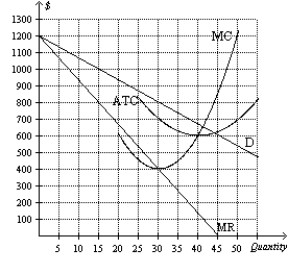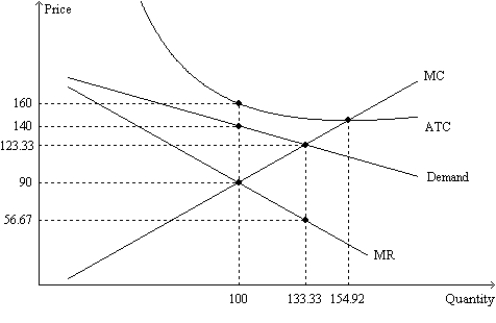A) have elastic demand curves.
B) are very different from generic products.
C) are indistinguishable from generic products.
D) consumer-advocate groups have found to be inferior.
F) A) and C)
Correct Answer

verified
Correct Answer
verified
Multiple Choice
A profit-maximizing firm operating in a monopolistically competitive market that is in a long-run equilibrium has
A) minimized average total cost.
B) chosen to produce where demand is unitary elastic.
C) produced the efficient scale of output.
D) chosen a quantity of output where average revenue equals average total cost.
F) A) and B)
Correct Answer

verified
Correct Answer
verified
Multiple Choice
"In a long-run equilibrium, price is equal to average total cost." This statement applies to
A) competitive markets, but not to monopolistically competitive markets or monopolies.
B) competitive and monopolistically competitive markets, but not to monopolies.
C) competitive markets, monopolistically competitive markets, and monopolies.
D) None of the above is correct.
F) A) and B)
Correct Answer

verified
Correct Answer
verified
Multiple Choice
Table 16-1
The following table shows the percentage of output supplied by the top eight firms in four different industries.  -Refer to Table 16-1. Which industry has the highest concentration ratio?
-Refer to Table 16-1. Which industry has the highest concentration ratio?
A) Industry A
B) Industry B
C) Industry C
D) Industry D
F) B) and C)
Correct Answer

verified
Correct Answer
verified
True/False
Oligopoly is characterized by a few sellers offering similar products, whereas monopolistic competition is characterized by many sellers offering differentiated products.
B) False
Correct Answer

verified
Correct Answer
verified
Multiple Choice
Figure 16-4  -Refer to Figure 16-4. At the profit-maximizing, or loss-minimizing, output level, how many units of output will the firm in this figure produce?
-Refer to Figure 16-4. At the profit-maximizing, or loss-minimizing, output level, how many units of output will the firm in this figure produce?
A) 20
B) 30
C) 40
D) This firm will choose not to produce.
F) A) and B)
Correct Answer

verified
Correct Answer
verified
Multiple Choice
In monopolistically competitive markets, economic losses
A) suggest that some existing firms will exit the market.
B) suggest that new firms will enter the market.
C) are minimized through government-imposed barriers to entry.
D) are never possible.
F) A) and B)
Correct Answer

verified
Correct Answer
verified
Multiple Choice
The higher the concentration ratio, the
A) more control an individual firm has to set prices.
B) more competitive the industry.
C) less competitive the industry.
D) Both a and c are correct.
F) B) and C)
Correct Answer

verified
Correct Answer
verified
Multiple Choice
Scenario 16-7 Consider the problem facing two firms, YumYum and Bertollini, in the frozen food market. Each firm has just come up with an idea for a new "frozen meal for two" which it would sell for $9. Assume that the marginal cost for each new product is a constant $2, and the only fixed cost is for advertising. Each company knows that if it spends $12 million on advertising it will get 1.5 million consumers to try its new product. YumYum has done market research which suggests that its product does not have any "staying" power in the market. Even though it could get 1.5 million consumers to buy the product once, it is unlikely that they will continue to buy the product in the future. Bertollini's market research suggests that its product is very good, and consumers who try the product will continue to be consumers over the ensuing year. On the basis of its market research, Bertollini estimates that its initial 1.5 million customers will buy one unit of the product each month in the coming year, for a total of 18 million units. -Refer to Scenario 16-7. Suppose YumYum has an opportunity to create a cheaper advertising campaign in newspapers rather than on television for its new product. This campaign will cost $8 million and is expected to result in the same 1.5 million one-time customers. YumYum should
A) invest in the cheaper campaign because they will earn a profit.
B) invest in the cheaper campaign because they will signal the high quality of their product.
C) not invest in the cheaper campaign because they will incur a loss.
D) not invest in the cheaper campaign because their brand name will be negatively affected.
F) A) and C)
Correct Answer

verified
Correct Answer
verified
Multiple Choice
One way in which monopolistic competition differs from oligopoly is that
A) there are no barriers to entry in oligopolies.
B) in oligopoly markets there are only a few sellers.
C) all firms in an oligopoly eventually earn zero economic profits.
D) strategic interactions between firms are rare in oligopolies.
F) None of the above
Correct Answer

verified
Correct Answer
verified
Multiple Choice
Figure 16-4  -Refer to Figure 16-4. The maximum total short-run economic profit for the monopolistically competitive firm in this figure is
-Refer to Figure 16-4. The maximum total short-run economic profit for the monopolistically competitive firm in this figure is
A) -$3,000.
B) $3,000.
C) $9,000.
D) $24,000.
F) All of the above
Correct Answer

verified
Correct Answer
verified
Short Answer
Scenario 16-3
Peter operates an ice cream shop in the center of Fairfield. He sells several unusual flavors of organic, homemade ice cream so he has a monopoly over his own ice cream, though he competes with many other firms selling ice cream in Fairfield for the same customers. Peter's demand and cost values for sales per day are given in the table below. (Everyone who purchases Peter's ice cream buys a double scoop cone because it's so delicious.)  -Refer to Scenario 16-3. When Peter maximizes his profits, how much revenue does he earn per day?
-Refer to Scenario 16-3. When Peter maximizes his profits, how much revenue does he earn per day?
Correct Answer

verified
Correct Answer
verified
Multiple Choice
The debate over the efficiency of markets in which products with brand names are sold
A) is framed by the role of regulation in advertising.
B) is likely to be resolved by reference to anecdotal evidence.
C) hinges on whether consumers are rational in their choices.
D) hinges on the effectiveness of advertising that identifies price differences.
F) B) and C)
Correct Answer

verified
Correct Answer
verified
Multiple Choice
Which of the following goods are not likely to be sold in monopolistically competitive markets?
A) jeans
B) books
C) tap water
D) clocks
F) A) and C)
Correct Answer

verified
Correct Answer
verified
True/False
The product-variety externality and the business-stealing externality are both spillover costs of new firms entering a monopolistically competitive market.
B) False
Correct Answer

verified
Correct Answer
verified
Multiple Choice
Figure 16-10
The figure is drawn for a monopolistically-competitive firm.  -Refer to Figure 16-10. In order to maximize its profit, the firm will choose to produce
-Refer to Figure 16-10. In order to maximize its profit, the firm will choose to produce
A) 100 units of output, and its profit will be negative.
B) 100 units of output, and its profit will be zero.
C) 133.33 units of output, and its profit will be negative.
D) 133.33 units of output, and its profit will be zero.
F) B) and C)
Correct Answer

verified
Correct Answer
verified
Multiple Choice
Advertising that uses celebrity endorsements is most likely intended to
A) increase elasticity of demand for the advertised product.
B) reduce the ability of markets to allocate resources efficiently.
C) provide a signal of product quality.
D) be useful only for psychological effects.
F) A) and C)
Correct Answer

verified
Correct Answer
verified
Multiple Choice
Which of the following statements is not correct?
A) Monopolistic competition is different from monopoly because monopolistic competition is characterized by free entry, whereas monopoly is characterized by barriers to entry.
B) Both monopolistic competition and oligopoly fall in between the more extreme market structures of competition and monopoly.
C) Monopolistic competition is different from oligopoly because each seller in monopolistic competition is small relative to the market, whereas each seller can affect the actions of other sellers in an oligopoly.
D) Both monopolistic competition and perfect competition are characterized by product differentiation.
F) A) and B)
Correct Answer

verified
Correct Answer
verified
Multiple Choice
A monopolistically competitive industry is characterized by
A) many firms selling products that are similar but not identical.
B) many firms selling identical products.
C) a few firms selling products that are similar but not identical.
D) a few firms selling highly different products.
F) A) and B)
Correct Answer

verified
Correct Answer
verified
Multiple Choice
The product-variety externality arises in monopolistically competitive markets because
A) firms produce with excess capacity.
B) firms try to differentiate their products.
C) firms would like to produce homogeneous products, but the large number of firms prohibits it.
D) entry and exit is restricted.
F) C) and D)
Correct Answer

verified
Correct Answer
verified
Showing 261 - 280 of 580
Related Exams